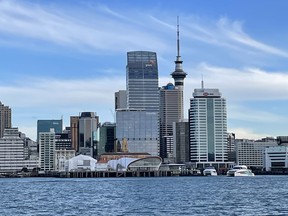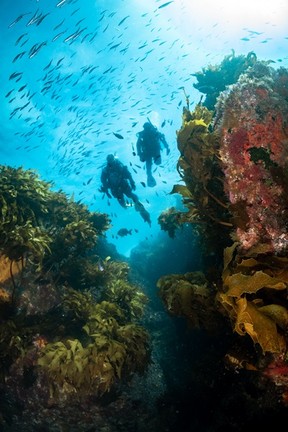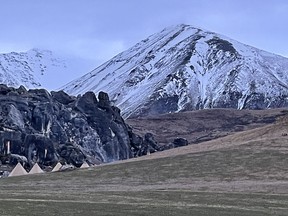Feeling on top at the bottom of the world
Reviews and recommendations are unbiased and products are independently selected. Postmedia may earn an affiliate commission from purchases made through links on this page.
Article content
From the pristine waters in the Poor Knights Marine Reserve on the North Island, to the glistening and majestic Franz Josef Glacier on the South Island, New Zealand is overflowing with natural wonders.
I arrive just as the sun is setting over a calm bay and vast, green parkland near the northeast tip of the country. This is the birthplace of the nation, where Maori chiefs and the British Crown signed the Treaty of Waitangi, on Feb. 6, 1840.
Advertisement 2
Article content
It’s beautiful and peaceful as I make my way along the coastline and take a short ferry ride to Russell. The picturesque town, population 700, sits on a peninsula and was the first capital. It also lays claim to having the first licensed hotel — the charming Marlborough Hotel, which dates back to 1827.
Russell is popular in the summer (think December to February in the Southern Hemisphere) and a great place to explore the Bay of Islands area — named for the 144 small islands nearby. It boasts white, sandy beaches, dolphins and hilly vistas.
The next day, I take a scenic route a couple of hours southeast to Tutukaka, population 830. The little-known town could easily be overlooked, but that would be a mistake. The Poor Knights Islands, about 20 kilometres off the coast, have volcanic origins dating back about 10 million years, which have created fantastic cliffs, arches and caves.
Article content
Advertisement 3
Article content
Thanks to the area being a protected reserve, there are more than 125 species of marine life in the subtropical and temperate waters. Mat Wallace, with Dive! Tutukaka, takes a couple of us out to explore it.
We see a school of blue maomao, demoiselles and mating nudibranchs among other creatures, while diving. The visibility is great and although the water is cool in wintertime, I’m amazed we have the place to ourselves.
There’s a sense of awe and wonder, of being wildly far away and immersed in nature, and it’s repeated in other stunning parts of the country — more of which later.

New Zealand’s biggest city, Auckland, with a population of about 1.4 million, beckons. It’s buzzy and modern and yet surrounded by beaches, dormant volcanoes and two harbours — adventure is never far away.
Advertisement 4
Article content
I go for a relaxing sail, taking in the skyline, the Harbour Bridge and the hilly suburbs. Back on the mainland, I head to the Sky Tower and take the glass elevator up 220 metres for fantastic 360-degree views and another beautiful sunset over the water.
In Auckland and the rest of the country, I’m spoiled with excellent foodie experiences time and again. New Zealanders joke that they live at the bottom of the world and it’s true. It’s remote, but this combined with a good climate, 14,000 km of coastline and world-class vineyards has created a culture that values fresh, local produce and a vibrant culinary scene.
Award-winning chef Ben Bayly is passionate about it all. He sourced signature ingredients for a one-night only, pop-up restaurant in the foothills of the Southern Alps, about 95 km northwest of Christchurch on the South Island.
Advertisement 5
Article content
His extraordinary six-course menu featured tahr tartare; abalone; a truffle broth served with wagyu kebabs; smoked crayfish; lamb cooked in a traditional Maori underground oven; and the piece de resistance — a spit-roasted pineapple with Miann chocolate, Heilala vanilla and Dreamview organic jersey cream. The entire experience, under a starry sky, surrounded by mountains was unforgettably delicious.
You can taste some of the dishes at Bayly’s restaurants throughout the country.
From Tutukaka’s Schnappa Rock restaurant, where chef Dean Thompson (a finalist for Hospitality New Zealand’s latest chef of the year award) serves some of the Northland region’s finest produce, to the Big Fig, a sustainable cafe on Lake Wanaka in the Otago region of the South Island, the parade of mouth-watering food is amazing. The same can be said for vineyard restaurants, such as Tussock Hill in Christchurch and the Carrick Winery and Restaurant in Bannockburn, Otago.
Advertisement 6
Article content
From Christchurch, I take the TranzAlpine train about 220 km west, passing cliff-lined river gorges, the Southern Alps and beautiful mountain lakes en route to Greymouth. The five-hour journey is a teaser for what lies ahead.

Driving south on Highway 6 along the Tasman Sea coast, I cross over small, one-way bridges, passing forests, waterfalls, crystalline lakes and four national parks to reach Franz Josef, population 530.
This breathtaking southwest corner of the country is a UNESCO World Heritage Site, shaped by the great Alpine Fault, where the Indo-Australian and Pacific continental plates make contact on land.
The fault line runs right under the spectacular Franz Josef Glacier. To get there, I take a short walk through a temperate rainforest and a helicopter up 1,300 metres. Fun fact — this is one of three glaciers in the world that descends into a rainforest. (The others being Fox Glacier in New Zealand and Perito Merino Glacier in Argentina.)
Advertisement 7
Article content
My guide Aiden Davies leads a handful of us through this incredible landscape — filled with giant ice towers and blue ice crevasses, all enveloped by snow-covered peaks. Winter is the best time to hike here, he says, as he uses his axe to clear a path. Again, I find myself with a handful of people — with no one else in sight — soaking up nature at its best.
To fully appreciate the vast beauty of the Southern Alps, I take a flight in a four-seater Cesna. Scott Cooper, my pilot with the family run Southern Alps Air, points out the sights — Mount Aspiring, the highest peak in the range at 3,048 m, the Volta and Therma glaciers and the Olivine Ice Plateau — all of it is absolutely stunning.
We make a quick stop in Milford Sound fiord before returning to the tiny Wanaka Airport.
There’s so much to see and do in New Zealand, but I have to catch my flight home and so I make my way to Queenstown. Once there, I revel in views of Lake Wakatipu and the Remarkables Mountain Range and take the Skyline Gondola up a peak to gaze out at the star-filled sky.
It’s the perfect way to say farewell to an awe-inspiring country.
The writer was a guest of Tourism New Zealand and flew Air New Zealand. The organizations didn’t review this article.
Article content

